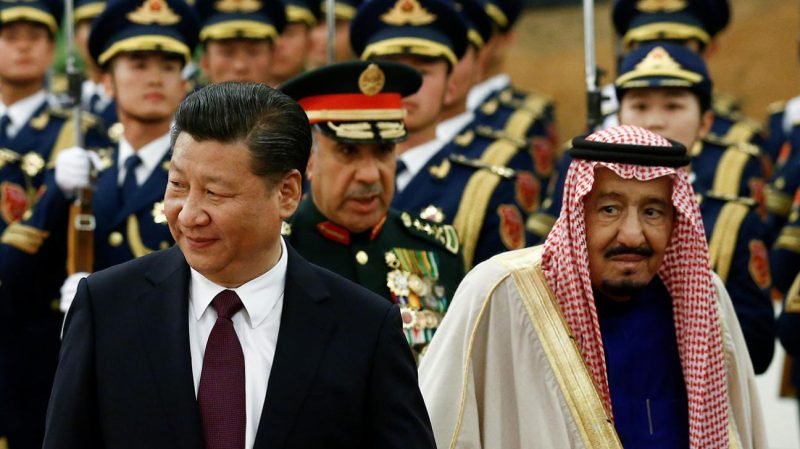Beijing and Riyadh: Burgeoning engagement rooted in mutual benefits

Economic engagement is the crux of Chinese engagement in West Asia. Since the advent of premier Xi Jinping, Beijing’s foreign policy has taken a significant turn to be more assertive, and the energy security requirements have risen, driven by the need for substantial economic and military modernization. More than 60% of China’s crude oil imports are from the Middle East. China maintains excellent relations with all nations in the Gulf Cooperation Council. It strategically takes a neutral stand in their regional rivalries. Saudi Arabia being the world’s top oil exporter is keenly ambitious to find the market for its exports and enhance its influence in the Arab and Islamic world. This mutuality between the world’s largest crude oil producer and customer has eventually led to deepening Beijing-Riyadh cooperation, which also led to engagements in various other fields.
In July 2020, both celebrated 30 years of bilateral relations in which top-level leadership of both nations reaffirmed mutual support to promote regional and global security. Saudi Arabia constitutes a crucial pillar in Chinese energy security initiatives. The Kingdom is of great importance to Beijing, even beyond energy cooperation.
The strategic location of Riyadh makes it a vital hub connecting three continents. It is a significant point in China’s One Belt -One Road Initiative and a crucial point of interconnection to Africa and Eurasian Hinterland. This article analyses the existing engagements between China and Saudi Arabia, giving a holistic view beyond much-highlighted energy diplomacy.

Assessing Sino-Saudi ties overtime
The origin of Beijing’s economic ties with Riyadh dates back to the ancient silk road. Very little economic and political engagements that existed in the 1930s and 40s got restricted after the advent of the Chinese Communist Party in 1949. In 1990 the formal diplomatic ties between Beijing and the Kingdom were set up. However, the 1985 covert purchase of some ballistic missile from China validates the presence of ties even before. Since then, both have maintained a robust bilateral engagement through cooperation and engagement in various fields. The 2008 joint statement on strengthening cooperative and strategically friendly relations upgraded their relations into a strategic partnership.
Multilateral cooperation forums such as China Arab states cooperation forum and China Gulf cooperation council Strategic Dialogue (GCC) have further enhanced bilateral cooperation. By 2013, Beijing became Riyadh’s top trading partner. On the sixth ministerial meeting of CASCF, Chinese premier Xi Jinping proposed a “1+2+3” partnership model consisting of energy, infrastructure, trade & investment and nuclear energy, space satellite, and new energy. On January 19, 2016, they signed a joint statement on establishing comprehensive and strategic partnerships. The formation of the Saudi-Chinese High-level joint committee acted as a decisive step in moulding the future of mutual coordination. The regular interaction between top-level leaderships of both nations has done smoother policy planning. Although both have a substantial difference in their socio-political scenarios, they share a mutuality of having regional dominance, being enigmatic in top levels of government and geopolitical ambitions, which still holds them the most significant trading partners.

Arenas of mutual cooperation
Energy cooperation
Saudi Arabia remains the top oil supplier to China, with the oil import rising to 8.8 million tons or 2.16 million barrels per day. The supplies increased 15% more than a year ago, especially considering the increasing demand following price fall due to pandemic. In November 2019, Chinese state-owned firms, including the Sinopec group, the silk road fund, were considering a USD 10 billion worth in Saudi Aramco’s IPO. The shift in Aramco’s marketing strategy in dealing with private refineries and the state-run in China has helped increase China’s import previous year. In the previous year, Saudi Aramco signed an MOU to build a refinery and petrochemical project in a Northwestern province in China. Also, Saudi Basic Industries Cooperation (SABIC) has agreed with Sinopec to develop petrochemical projects in both nations. Both have a mutual interest in maintaining regional market stability.
Military Ties
The defence cooperation of Riyadh with Beijing started as early as 1985 with the covert purchase 0f 36 CSS-2 East wind intermediate-range ballistic and nine missile launchers from China. Till 1988 these military dealings were kept confidential to avoid enraging Riyadh’s then potential ally US. In 2016 November, both signed a five-year plan for security cooperation in the fields of counterterrorism cooperation and joint military drills. In 2019, Saudi opened the joint naval special forces exercise with China -A blue sword aimed at counteraction to maritime terrorism and piracy. The recent report by WSJ on Riyadh’s construction of a facility to extract Uranium yellowcake from Uranium ore, which could be a vital content in nuclear weapons and reactors with Chinese assistance, has created an alarm.
Beijing has supplied Intermediate-range ballistic missiles such as the Dongfeng DF-3A and DF-21 to Riyadh over the years. Riyadh had been looking forward to reducing its dependency on the US for security and defence supplies. China has also made agreements to supply its drone technology, and the Kingdom is planning to set up the first factory for Chinese aerial drones. The Kingdom is the world’s second-largest arms importer with fierce support of Chinese technology, which may contribute destructively to the Middle East arms race and its ongoing strains with Yemen and Iran.
Culture and tourism
Cultural and educational exchange can act as a vital boost to enhance bilateral ties. The cultural exchanges between Riyadh and Beijing date back to over 2000 years to the flow of trade across the ancient silk road. Educational exchanges can act as a great catalyst to bridge cultural differences.
In 2019, Saudi Arabia planned to introduce the Chinese language curriculum in all levels of education in Saudi’s educational ventures to bridge the bond of communication. Tourist flows from China can be a significant boost to the economy of Riyadh. Labor and tourist flows are usually uni-directional from China to Saudi. There is a significant increase in the exchange of human capital in labour and education in the past decade. There has been a more than 50% increase in Chinese labourers working in the Kingdom from 2011-2016. Religious and socio-political differences still form a crucial barrier in bridging the cultural gap.
Covid-19 response
Beijing gave amble support and helpline to Riyadh in dealing with the global pandemic. It provided the Kingdom with free medical supplies, including testing kits and masks as donations from China’s Ningxia Hui Autonomous Region. It also sent for a team of experts to induce epidemic prevention training and offer virus-containing compatibility to the Kingdom. Chinese companies also went for a cooperation agreement for lending help to build six large laboratories in Riyadh to improve its virus detection capability. It would be a vital step in strengthening ties on their cooperation on health and quality of living.
Compatibility of BRI with Saudi’s Vision 2030
The BRI is gaining greater importance and is supposed to contribute more than 80% to the global economic growth by 2050. The Middle-east plays a crucial role in meeting the energy demands of this initiative. Riyadh has officially rendered its full-fledged support and active participation in the promotion of interconnectivity under BRI. Saudi’s vision 2030 is a socio-economic package presented first on the G20 Hangzhou summit in 2016, aimed to diversify the Kingdom’s economy to decrease its over-dependence on oil exports. It paves the way for Saudi’s ambitions to be a global investment powerhouse in the coming years and constitute a sustainable development model diverting from the overuse of petroleum. The establishment of the Sino-Saudi high-level joint committee was for enhancing coordination between Policy options of BRI and Vision 2030.

Riyadh looks forward to high scale investments of Beijing in non-oil industries such as tourism and manufacturing for aligning with the goals of the vision. The significant help of Beijing on completing the Mecca-Medina high-speed railway, connecting two holiest sites in Islam, has enhanced the role of Saudi in the Islam world. Accelerating mutual trade and investment opens tremendous opportunities for collaboration. Riyadh is one of the founding members of the Asian Infrastructure Investment Bank led by China, whose prime focus is on infrastructure construction. The development of Jazan city of primary and downstream industries at the coast of the Red sea will supply Chinese investors with a particular developmental area.
China’s Pan -Asia PET Resin’s USD 1 Billion developmental projects in Jazan was one of the major initiatives. A Free trade agreement between Beijing and GCC would be a significant acceleration to the flow of mutual FDIs and stimulate trade diversification. Saudi’s USD 20 Billion investment package in Gwadar port in Pakistan for an oil refinery became a vital partner in CPEC. Unification of bilateral policy objectives would pave for a more robust path for future endowments. Riyadh faces some drawbacks in fulfilling in its highly ambitious Vision 2030. It lacks human capital, inadequate technological streams, and its strict religious elements also become a hindrance. Moreover, Economic decisions are influenced primarily by Socio-Political, moral, cultural, and religious stands. Thus embeddedness may lead to Chinese firms prioritizing the Asian parallels over Saudi.
Conclusion
Beijing and Riyadh share mutually beneficial relations in various significant areas. There are still many unexplored options to enhance this cooperation. They should expand their energy diplomacy over traditional crude oil to new low carbon and renewable energy, which is also a clause of Saudi’s vision 2030. A well-structured policy coordination framework is required to bridge the existing gap. Lowering trade barriers and establishing new financial instruments can help strengthen existing bilateral relations. Riyadh also participates in China’s BeiDou cooperation forum.
Albeit of rising trade levels and growing multifaceted engagement, Beijing-Riyadh relations lack long term stability. Apart from economic engagement, both have divergent stand regarding crucial regional issues. PRC maintains cordial relations with Saudi’s rivals Israel and is negotiating on a 25year old Comprehensive strategic partnership with Tehran. China will receive oil on a subsidized price if the pact with Iran cames into practice, which would decrease the Chinese dependence on oil from Riyadh. Their extremely different nature of Socio-Political scenario, Religious identity, and long-term ambitions also act as antagonists in deepening the existing bilateral ties. The China-Saudi ties symbolize a pragmatic policy alignment.



















